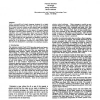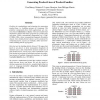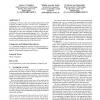492 search results - page 59 / 99 » Integrating Ontology Languages and Answer Set Programming |
VLDB
1987
ACM
14 years 6 days ago
1987
ACM
FAD is a powerful and simple language designed for a highly parallel database machine. The basic concepts of the language are its data structures (which we call objects) and its p...
WWW
2008
ACM
14 years 9 months ago
2008
ACM
Easy reuse and integration of declaratively described information in a distributed setting is one of the main motivations for building the Semantic Web. Despite of this claim, reu...
KBSE
2002
IEEE
14 years 1 months ago
2002
IEEE
GenVoca is a methodology and technology for generating product-lines, i.e. building variants of a program. The primitive components from which applications are constructed are ref...
ATAL
2009
Springer
14 years 3 months ago
2009
Springer
In planning as well as in other areas, temporal logic has been used to specify so-called temporally extended goals. Temporally extended goals refer to desirable sequences of state...
WWW
2003
ACM
14 years 9 months ago
2003
ACM
The Semantic Web envisions a World Wide Web in which data is described with rich semantics and applications can pose complex queries. To this point, researchers have defined new l...



